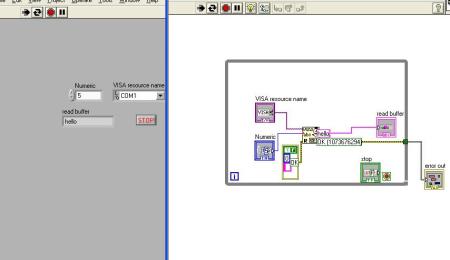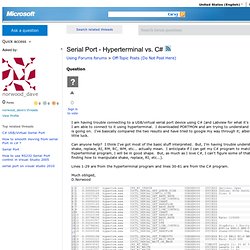Labview Virtual Serial Port

In computing, a serial port is a serial communication physical interface through which information transfers in or out one bit at a time contrast parallel port.
Selection of software according to Create virtual com port by labview topic.

Using Virtual COM Ports or Third-party USB-to-Serial Adapters with VISA in MAX

In reply to jan2809: Hi jan2809, It sounds like LabView doesn t like something about the serial port definition. It might be trying to set an OS port attribute that.
This document explains some basic serial communication techniques. For more information on serial communication concepts and terminology, see the related link Serial Communication General Concepts.
1. Loopback Test to Verify Hardware Operation
There are three ways to verify the operation of the serial port: LabVIEW, HyperTerminal, and LabWindows/CVI. All perform a loopback test on the serial port by shorting out the Transfer and Receive pins on the cable connected to that port. Step 1 is the description for shorting the pins and is the first step to all three. The LabVIEW procedure is listed below, and both the HyperTerminal and LabWindows/CVI procedures are linked at the end of the page. Use the following procedure if you are using LabVIEW.
Connect a cable to your serial port. The most common port is a 9-pin or 25-pin DB-9 or DB-25 RS-232 port. On the cable, short lines 2 and 3. This connects the Transfer line coming out of the computer to the Receive line going in. Once shorted, the top row of the DB-9 cable should look like this: 1 2 3 4 5. An easy way to short pins 2 and 3 is to use a paper clip. If you have a female RS-232 cable, bend the paper clip and stick the ends in the second and third hole. If you have a male cable, bend the paper clip in a way that you shorten the long loop to the same length as the short loop. Then you can clamp it on the two pins.
On an RS-485 port, voltages are referenced differentially. Therefore, short TXD and RXD together and then TXD- and RXD- together pin 4 to 8 and pin 5 to 9 on a DB-9 cable; pin 1 to 5 and pin 2 to 4 on a Combicon connector. Make sure your software is configured in four-wire mode.
For HyperTerminal or LabWindows/CVI, follow the links at the end of the page.
For LabVIEW, follow the link Loopback Test for Serial Port. This takes you to the Loopback VI in the Example Program Database, which is a part of the Technical Support page. You need to unzip the file. This VI is written in LabVIEW 4.0.1 and will write a string of words out of the serial port and then read them back in. Before running the VI, make sure to set the port channel correctly. In LabVIEW, zero represents the first serial port. PC: 0 COM1, 1 COM2, Mac: 0 Modem, 1 Printer, Sun: 0 ttya, 1 ttyb,
If this works correctly and the string of words is read back in, the serial port hardware works. Most serial port communication problems are in the program and concern timing of read/writes calls or configuration of the serial port.
Back to Top 2. Common Problems
Most problems are in the program, not the hardware. Always use example programs as a reference point for ways to wire the diagram panel. Use the sample VIs shipped with LabVIEW under Help Search Examples or from the VIs located in the Examples Program Database linked at the end of the page.
Port Referencing: In LabVIEW, ports are numbered starting at zero. Therefore, port 0 in LabVIEW is COM 1 on a PC.
PC: 0 COM1, 1 COM2, Mac: 0 Modem, 1 Printer, Sun: 0 ttya, 1 ttyb,
Timing In Program, Hanging: Many times, a read operation is performed on a port that results in the Serial Port Read VI stopping and waiting or hanging. One way this can happen is if a read operation is done to the port and the program specifies a certain number of bytes that the Serial Port Read VI should get. The Serial Port Read VI was told to get a designated number of bytes; if there are not that many bytes in the serial port receive buffer, it waits until more bytes are written to the serial port. If no more bytes are written to the serial port to complete the operation, the program hangs and waits indefinitely. This can be eliminated by using the Serial Read with TimeOut VI in Help Search Examples Serial Communication. Another method is to use the Bytes At Serial Port VI to check the port and see how many bytes are in the buffer. Wiring the result as the input for the number of bytes to read ensures that the read operation completes. Looking at the examples under serial communication in LabVIEW is an excellent starting point.
Timing In Program, Incomplete Transfer: A common problem is when a read operation is done on the serial port and it does not get the complete string of information expected. This may happen when you have a read operation happening before the write operation has time to complete. This could be resolved by using a Sequence structure or by using data flow dependency. Using a Sequence structure with the read after the write will make sure the data is completely written first. Using data flow requires a wire to be connected to the read VI after downstream the initial write VI.
Instrument s Termination Character: Serial communication can be very tricky when trying to communicate with devices, because the serial port will output exactly as programmed. This means you must know and program the exact sequence of code, including termination characters, to ensure the instrument operates properly. Common problems occur in not using the termination character required by the instrument or by leaving an extra space/character in the instruction string. There is a new standard for communicating with devices in LabVIEW called Virtual Instrument Software Architecture VISA, a single interface library for controlling VXI, GPIB, RS-232, and other types of instruments. If you are having problems with serial I/O, VISA is a great way to help eliminate termination character errors and make your code reusable and interchangeable between devices in the future.
Back to Top 3. Virtual Instrument Software Architecture VISA
VISA is a single interface library for controlling VXI, GPIB, RS-232, and other types of instruments on all LabVIEW platforms. VISA is a standard endorsed by the VXIplug play Systems Alliance, which includes more than 35 of the largest instrumentation companies in the industry. The VISA standard unifies the industry to make software interpretable and reusable over time and regardless of instrument I/O operation. Linked below is a page to help with VISA questions. VISA VIs for LabVIEW 4.x are linked at the end of the page.
Serial, GPIB, and VXI Communication with Measurement Studio VISA
Back to Top 4. Printing Reports Error 37
LabVIEW 5.1 for Windows includes Report Generation VIs that allow you to send text to the printer. For an example of how to use the Report Generation VIs, select Help Search Examples Advanced Report Generation. For printing with serial communication and earlier versions of LabVIEW, see the link below.
If the printer is connected to a local parallel port as LPT1 or LPT2, etc., you can use the Serial Port Write VI. For more information, see the Serial Port VIs chapter in your LabVIEW documentation.
If the printer is a network printer, you cannot use the Serial Port Write VI; you must use other methods to print, such as one of the following:
Use Programmatic Printing of a subVI to programmatically print a string. Select Print VI When VI Completes Execution in VI Setup of the subVI.
Use the System Exec VI to print a string programmatically by using Notepad.exe. The string to use in the System Exec VI could be: Notepad.exe /p c: junk.txt, where junk.txt is the name of an ASCII text file containing the text to be printed.
For problems with Error 37, follow the link below to check the settings in the labview.ini file.
Error 37 and writing to the Parallel Port with LabVIEW
Back to Top 5. Modem Communication in LabVIEW
Companies in the Alliance Program support modem communication in LabVIEW very well. National Instruments recommends these companies because of their quality work.
Back to Top 6. User Support Newsgroups
The Developer Exchange newsgroups are Usenet newsgroups covering National Instruments products, as well as general fields of science and engineering. You can read, search, and post to the newsgroups to share solutions and find additional support from other users. Past questions and solutions are also stored at this site for search purposes.
Back to Top 7. Advanced Troubleshooting of COM Port Data
Advanced users who want to analyze the exact bits being transferred over the serial port to detect differences between programs for example, LabVIEW vs. HyperTerminal can use a program called Portmon. System Internals provides Portmon, and the company s Web site provides you advanced utilities, technical information, and source code related to Windows 9x and Windows NT/2K internals.
Testing Serial Communication using HyperTerminal
Testing Serial Communication using CVI
Using the VISA classes in Measurement Studio to Perform Serial Communication.
- Virtual Serial Port COM Emulator VSPE French description : english is after Cet exemple utilise un programme gratuit de management de ports COM : VSPE.
- For more information on serial communication concepts with devices in LabVIEW called Virtual Instrument Serial Port VIs chapter in your LabVIEW.
- EXAMPLE - Serial Port Forwarding Port Sniffer/Logger - Overview This example demonstrates reading data from one serial port and forwarding this data to be written.
- Bluetooth Virtual Serial Port Bluetooth Serial Port profile enables you to use LabVIEW Serial VIs to open a connection to and exchange data with other Bluetooth.
Serial Communication Starting Point
I m having trouble using my virtual COM port or third-party USB-to-serial adapter in Measurement Automation Explorer MAX. I keep getting VISA errors. What s wrong.
Most virtual COM ports and many low cost USB-to-serial adapters do not fully comply with the serial specification and therefore do not support a lot of the functions that VISA uses, such as asynchronous I/O and flushing.
If you make your own VISA calls either through a VISA test panel in MAX or a development environment and avoid any calls that aren t supported by the driver for your virtual COM port then it may work, but because each virtual COM port implements different functionality, they are not officially supported by MAX or VISA.
Note: Another work around would be to try adding a token to the visaconf.ini file:
WriteTimeoutGranularity 0 under section ASRL-RSRC-ALIAS.
KnowledgeBase 3E79Q7IT: Using NI-VISA to Communicate with Third-Party Serial Card
KnowledgeBase 4FDEG8C5: Where is the visaconf.ini File Located.
You can use a Bluetooth virtual serial port, which provides a Serial Port Profile with a virtual serial driver, with the Mobile Module. A Serial Port Profile defines.
